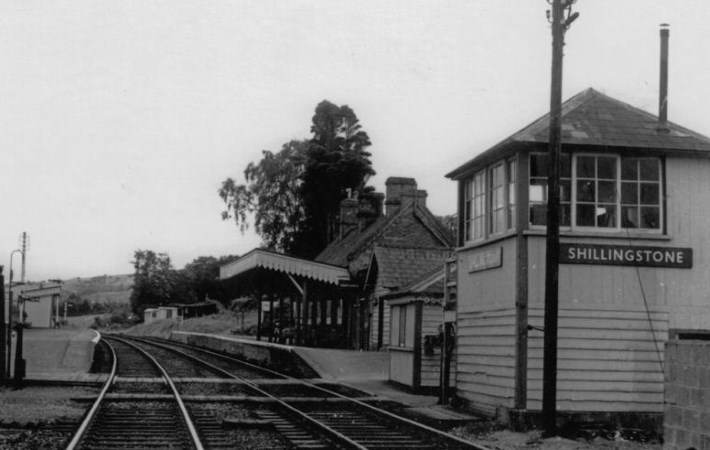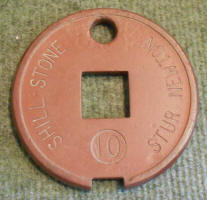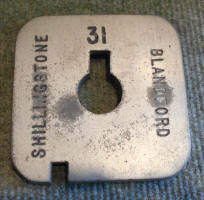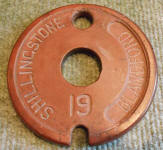 |
Somerset &
Dorset Joint Railway Signalling at Shillingstone |
 |
||||
|
||||||
|
||||||
The railway station at Shillingstone was located in the county of Dorset, on the southern part of the main line of the Somerset & Dorset Joint Railway (S&DJR) from Bath to Wimborne. The southern end of the S&DJR was constructed originally by the Dorset Central Railway (DCR), which was opened on 1-November-1860 as a single-track line from Wimborne to a temporary station at Blandford St Mary. In 1863 the DCR was extended northwards to join with the Somerset Central Railway (SCR) and Shillingstone was the first station on the new line north of Blandford. The DCR and SCR had merged in 1862 to form the Somerset and Dorset Railway, which became the S&DJR in 1875 when the line was leased jointly by the Midland Railway (MR) and London & South Western Railway (L&SWR). After the Grouping of the railways of Great Britain in 1923 the S&DJR remained a Joint line, but now under the control of the London, Midland & Scottish Railway (LMS) and the Southern Railway (SR), who were the successors to the MR and L&SWR respectively. When the railways were nationalised in 1948 the Joint line came under the control of British Railways (Southern Region) (BR(SR)), but by January 1963 control as far south as Shillingstone had passed to BR(Western Region) (BR(WR)) until the S&DJR closed on 6-March-1966.

Shillingstone station looking south in the 1960s
It is unclear exactly what the arrangements were at Shillingstone station when it was opened in 1863, but it is probable that there was only one platform provided on the Up side of the line. There may have been goods sidings provided on that side of the line as well at that time. It would appear that a proper passing-loop (with two platforms) and signal-box (SB) were not provided until 1878.
| Known Signalling Changes at Shillingstone | |
|---|---|
| Date | Details of Change or Proposal |
| 1875 | Following an inspection of the entire line a meeting of the S&DJR Officers was held on 30th September and 1st October, at which decisions were made about many improvements on the line. Minute 27 recorded for Shillingstone "Loop to hold 40 wagons and engine and tender, and platform for down line" and Minute 34 included Shillingstone in a list of places where crossing places were to be constructed or extended. |
| 8-November-1876 | S&DJR Officers' Minute 386 recorded "Switch to be provided at Shillingstone. Signal box to be fixed, and signals worked from it. Sidings to be provided with catch points and Annett's key. Estimated cost £240." |
| 5-October-1877 | S&DJR Officers' Minute 709 recorded a recommendation to provide a 'passing place' at an estimated cost of £400. |
| 17-October-1878 | Board of Trade (BoT) Inspection Report (MT6/215/7) of new signal-box (15 levers), new loop and new down platform. At this time both ends of the loop were worked from the signal-box (there was no ground-frame) and reference to Ordnance Survey maps would suggest that both points were about 150 yards from the box (the contemporary maximum permitted distance for direct mechanical operation). CR Clinker recorded from S&DJR Signal Instruction (SI) No 16 that a "loop and down platform" were brought into use on 21-October-1878. |
| 4-November-1886 | Block Telegraph working of single-line sections to Sturminster Newton and Blandford replaced by Electric Train Tablet (ETT) working, using Tyer's No 1 pattern instruments. |
| 23-January-1891 | S&DJR Officers' Minute 3924 recorded a recommendation to extend the loop at an estimated cost of £445. It is probable that it was this work which resulted in the provision of the ground-frame (GF) at the south end, which is known to have been in place by 1901. |
| 29-July-1901 | S&DJR Officers' Minute 5233 recorded a request for the Engineer to prepare a plan for a 'lie-bye siding'. |
| 12-December-1901 | BoT Inspection Report (MT6/1060/2) of 'new siding at south end' (this became Down Siding East). Diagram shows, and Report confirms, that there was an 'old' GF already in use. |
| 20-February-1902 | BoT Inspection Report (MT6/1060/2) of replacement 15-lever frame in the signal-box. Previous frame described as 'old and out-of-date', but GF remained in use. Signalling installation essentially unchanged, but lever numbering altered. Frame was of the Stevens pattern, but the manufacturer is unknown. |
| 29-May-1905 | In connection with the opening of a new passing-loop and SB at Stourpaine, Tyer's No 1 instrument for section to Blandford replaced by McKenzie & Holland 'square tablet' instrument for 'long section' working. Tyer's No 6 instrument added for 'short section' working to Stourpaine. |
| 10-September-1911 | Up Home signal (No 14) moved 14 yards farther out (SI 225). |
| 21-September-1911 | New Up Outer Home signal provided 264 yards in rear of the Up Home and the latter renamed Up Inner Home (SI 226). Both signals worked by the same lever (No 14). |
| 1915 | It is believed that in this year the GF was abolished and control of the facing points and FPL at the south end of the loop was transferred to the SB lever-frame, which was extended to 16 levers and re-locked accordingly. On 20th August a complete new set of description plates for 16 levers was ordered, consistent with the revised layout (SRS Archives). |
| 25-August-1931 | Down Distant (1) replaced on Down side of line 206 yards farther out (SI 316). |
| 27-August-1931 | Down Home (2) replaced on Down side of line 18 yards farther out (SI 316). |
| 2-August-1935 | A complete new set of 16 lever description plates was ordered (to the new SR style). |
| 18-May-1939 | According to SI 380 the trap point (6) in Down Siding West was to be moved
29 yards farther from SB, existing Point Indicator abolished and replaced by a
'TRAP POINTS' indicator (illuminated at night) at 178 yards from SB. (Note however a hand-written amendment dated 17-May-1939 in a Guard's book that the trap was moved 39 yards and the indicator was located at 188 yards, and this appears confirmed by details in later diagram copies.) |
| 21-May-1939 | Down Home (2) moved 48 yards farther out (SI 380). |
| 4-June-1939 | Down Loop points (5) moved 49 yards farther out (SI 380). |
| 11-June-1939 | Up Siding points (7) moved 17 yards farther out and its Point Indicator abolished (SI 380). |
| 5-October-1941 | Up Distant (16) moved 290 yards farther out and now at 1193 yards from the Up Outer Home (SI 386). |
| post-1950 | The Up Inner Home, previously a LQ arm on a S&D-type rail-built post, was replaced by an UQ arm on a SR-type rail-built post sometime after September 1950 (possibly when the Up Outer Home was abolished, see entry below for 1954). |
| 14-January-1951 | Tyer's No 1 ETT instrument for section to Sturminster Newton replaced by Tyer's No 6 pattern (S&D Weekly Notice). |
| 18-December-1951 | In connection with the abolition of the passing-loop and SB at Stourpaine, 'short' and 'long' section working abolished. McKenzie & Holland ETT instrument removed and Tyer's No 6 instrument now used for new section to Blandford. |
| 1952 | The Down Loop and Up Loop points (5 and 12) were renamed Up Loop and Down Loop points respectively (in accordance with contemporary BR(S) standards) and new lever description plates ordered on 20th June. |
| 1954 | It is believed that the Up Outer Home was abolished at this time (photographic evidence shows it was still in place in September 1950, but it had gone in the 1960s), as an order was placed on 13-April-1954 for a new description plate for lever 15, now described simply as 'Up Home'. |
| circa-1959 | Although the precise date for the provision of track-circuit 'A' is unknown, circumstantial evidence from an amended wiring diagram suggests that it was done in 1959. Certainly it was in use by the time of a January 1962 diagram copy. |
| 1965 | Notice K2/16/65 reports that the Down Siding East 'has been taken out of use' and its discs recovered, also that the Down Siding West 'has been recovered'. All had disappeared from a May 1965 diagram copy. |
| 1965 | Notice P/EW24 of 1965 states that the Up Sidings and the two connections to the Up line would be taken out of use on 8th July. |
| Single-Line Electric Train Tablets from Shillingstone | ||||||
|---|---|---|---|---|---|---|
| Sturminster Newton - Shillingstone | Shillingstone - Blandford | |||||
 |
 |
 |
 |
|||
| Tyer's No 1 Tablet | Tyer's No 6 Tablet | McK&H Tablet | Tyer's No 6 Tablet (see Note) | |||
| 1886-1951 | 1951-1966 | 1905-1951 | 1951-1966 | |||
| Click thumbnails to see larger images | ||||||
| Note: the Tyer's No 6 tablet for Shillingstone - Blandford has been re-engraved on the right-hand side because previously it was used for the Shillingstone - Stourpaine 'short section'. | ||||||
In 1905 the signal-box at Shillingstone (along with those at Stourpaine and Blandford) was one of the first S&DJR SBs to be equipped with the No 6 pattern of Tyer's ETT after the opening of the passing-loop at Stourpaine. In 1951 it became also one of the last S&DJR SBs to have a No 6 ETT instrument installed when the section to Sturminster Newton was upgraded from the original No 1 pattern.
Postscript...
On 6-March-1966 passenger services ceased on the whole of the S&DJR. Although a few sections remained open for goods traffic for a few more years most of the line was closed, including all of the ex-DCR north of Blandford and hence the station at Shillingstone. Although the track was lifted and most of the buildings demolished in due course, the main station building and both platforms remained as the only surviving ex-DCR station. The site is now an active preservation/restoration project under the North Dorset Railway Trust. In the mid-1990s Dorset County Council established a path along the former S&DJR trackbed for walkers, cyclists and horse-riders, and today this forms part of the North Dorset Trailway.
© CJL Osment 2017-23
Acknowledgements to the late Dr Peter Cattermole for relevant S&DJR material, and to John Creed and the
Signalling Record Society
for information from their archives. Tablet photographs courtesy David McGhie.
References
|
© West Country Railway Archives 2017 Page last updated: 16 March 2023 |
URL:
E-Mail: |
||||||